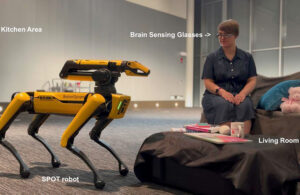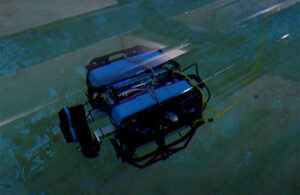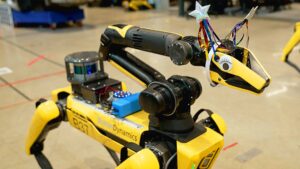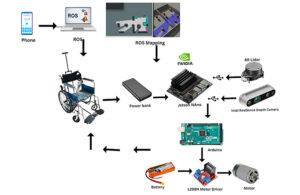A multimodal system uses models trained on language, vision, and action data to help robots develop and execute plans for household, construction, and manufacturing tasks.
Ddog project at MIT connects brain-computer interface with Spot robot
Project Ddog aims to turn a Boston Dynamics Spot quadruped into a basic communicator for those with physical challenges such as ALS.
Researchers developing more natural robotic leg control
An effort to create a control model that moves seamlessly between different activities like standing, walking and climbing stairs is renewed by the National Institutes of Health
MIT designs robotic heart chamber
The realistic model could aid the development of better heart implants and shed light on understudied heart disorders.
Northeastern students develop robotic boat to attack invasive plants
Northeastern University researchers have developed the Hydrilla Hunter, a robot designed to detect invasive plants in rivers.
USC helping robots quickly learn new tricks
RoboCLIP algorithm has been pre-trained on large amounts of video and textual demonstrations.
MassRobotics opens applications for Form and Function Challenge at Robotics Summit
MassRobotics second Form and Function Challenge is seeking university teams to create innovative and useful robotics.
AI Institute hires Marco Hutter to lead European office
Hutter, co-founder of quadruped maker ANYbotics, focuses on the development of robots with legged locomotion and manipulation.
Stevens Institute for Artificial Intelligence looks at prospects for AI and robotics
The Stevens Institute for Artificial Intelligence’s director shares his perspectives on AI policy, generative AI, and machine learning and legged robots.
Robots could help Japan combat 2024 trucker problem, IFR says
With new overtime regulations for truck drivers in Japan, the country could face labor shortages that robots can help address, said the IFR.
Northeastern University shows ‘experiential robotics’ in new EXP space
Robots at Northeastern University run the technological gamut, from NASA research to systems that could help the seafood industry.
Australia robotics industry overview published by HowToRobot
New research from HowToRobot and Robotics Australia Group reveals how Australia’s industry uses the country’s unique strengths in the global robotics race.
Toyota Research Institute emphasizes safety of AI-assisted driving
Toyota Research Institute demonstrated how it is developing AI and autonomous vehicles to interact with human drivers for safety.
Brown researchers simplify human-to-robot communication with large language models
Researchers at Brown University’s Humans to Robots Laboratory have developed software that helps robots understand plain-worded instructions.
Open Robotics releases Gazebo Harmonic simulator
The eighth version of the open-source simulator is one of the biggest Gazebo releases to date from Open Robotics.
5 takeaways from Universal Robots’ open house
Universal Robots had strong attendance at its U.S. headquarters open house, which featured presentations, demonstrations, and networking.
Boston Dynamics turns Spot into a tour guide with ChatGPT
Boston Dynamics integrated Spot with ChatGPT and other AI models as a proof of concept for the potential robotics applications of foundational models.
Underwater robot gives insight into ice shelf crevasses
A research team led by Cornell University is using an underwater robot, called Icefin, to gain a better understanding of ice shelf crevasses.
Meta’s FAIR team releases 3 tools for robotics researchers
The tools include a simulator, datasets, and an affordable technology stack that encompasses both hardware and software.
Northwestern researchers create robot-designing AI
The Northwestern team gave the AI a prompt to design a robot that can walk across a flat surface, and used the AI’s design as blueprints.
How this robotics student used NVIDIA Jetson to make an autonomous wheelchair
Robotics developer Kabilan KB is bringing autonomous navigation to wheelchairs with the aim of helping improve mobility for people with disabilities.
Tiny quadruped robots are powered by combustion actuators
Cornell researchers have combined soft microactuators with high-energy-density chemical fuel to create an insect-sized robot powered by combustion.






















